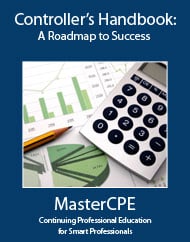Course Information
Controller’s Handbook: A Roadmap to Success
Course Information
| Title: | Controller’s Handbook: A Roadmap to Success |
|---|---|
| Category: | Accounting and Auditing |
| Field of Study: | Accounting |
| Course Code: | M278 |
| CPE Credits: | 15.0 |
| Price: | 93.95 |
Description
Description:
Today’s controllers are facing a complex and constantly changing business environment, pressuring their accounting departments to provide timely, accurate, and reliable information in a more efficient manner. The controller’s office is increasingly viewed as a business asset. Despite the uncertainty of the future, organizations look to the controller to provide clear insights using historical and forward-looking data.
This course will present recent research relevant to today’s controllers, describing the role of the controller in detail. He/she is at the center of the corporate universe due to the organizations’ need to capture, manage and leverage accounting and business data to enhance their performance in a competitive market. Dramatic changes in the business environment, such as increased globalization, changes in reporting requirements, rapid technological advancement, and the long-term impact of capital expenditures, have driven businesses to reevaluate the controller’s role. Most organizations now expect the controller’s office to be a central resource for critical business information to help drive strategic and critical decisions from the C-suite as well as across all operations.
Delivery Method: Online Interactive Self Study
Level: Overview
Prerequisites: None
Advanced Preparation: None
Course Details
Category: Accounting and Auditing
Field of Study: Accounting
Passing Score: 70%
Technical Details: Accounting is a technical field of study.
For More Detail:
If you are unable to view PDF then right click the mouse and click save link as
Objectives
Objectives:
- Identify the role of controllership
- Differentiate between the roles of controller and CFO
- Recognize the changing role and expectations of today’s controllers
- Recognize the challenges faced by controllers
- Identify strategies for building highly effective accounting departments
- Identify ways to improve cash management
- Recognize ways to accelerate cash receipts and/or delay cash payments
- Differentiate between cash forecasts and cash budgets
- Identify key steps involved in developing a cash forecast
- Recognize common instruments for cash investments
- Identify key control activities for cash receipts
- Recognize the impact of credit policies on accounts receivables
- Calculate the value of an organization’s accounts receivable
- Differentiate between the allowance method and direct write-off method
- Identify key control activities for accounts receivables
- Identify ways to optimize a business’ accounts receivable
- Identify the main characteristics of fixed assets
- Recognize the impact of fixed assets and depreciation on financial statements
- Identify the various types of depreciation methods
- Recognize the top issues associated with fixed assets
- Identify control activities related to fixed assets
- Identify the characteristics of merchandising, manufacturing, and service companies
- Identify several inventory costing methods including FIFO, LIFO, and the weighted average approach
- Distinguish between perpetual and periodic inventory systems
- Recognize important inventory management considerations
- Recognize the components of inventory cost
- Identify ways to optimize the Economic Order Quantity
- Identify key control activities for inventory and cost of sales
- Identify ways to optimize an organization’s accounts payable
- Recognize different techniques to prevent and detect irregularities in accounts payable
- Identify key control activities for accounts payable
- Distinguish between employees and independent contractors
- Recognize the responsibilities of a payroll department
- Calculate the gross earnings, withholding (payroll deductions), and net pay
- Recognize the best practices for leading a high-function payroll function
- Identify key control activities related to the payroll process
- Recognize the different financial statements and their uses
- Differentiate between the single-step and multistep income statements
- Identify the content of the statement of cash flows
- Identify differences for preparation of the statement of cash flows using the direct and indirect methods
- Recognize the purpose of notes to financial statements
- Identify the steps in the accounting cycle
- Record adjusting and closing entries
- Recognize the impact of adjusting entries on the financial statements
- Identify the purpose of closing entries
- Identify ways to improve the accuracy and speed of the closing process
- Recognize key financial ratios and how they can be used
- Calculate the value for different financial ratios
- Recognize various types of forecasts
- Identify steps in preparation of financial forecasts
- Identify the purpose of budgeting
- Recognize the major types of budget reports
- Identify advantages and disadvantages of budgets
- Recognize ways of increasing the value of budgets
- Identify examples of the master budgets
- Recognize the uses of capital budgeting
- Identify the different techniques used to evaluate business investments and their applications
- Recognize the concept of mutually exclusive projects
For More Objectives:
If you are unable to view PDF then right click the mouse and click save link as
Profession
NASBA: Yes
QAS: Yes
CPA: Suitable for all CPAs
IRS: No IRS credit for Enrolled Agents.
Profession Identifiers: CPA

